2015年11月山东省莒县英语说课大赛人教版九年级 Unit 10You’’re supposed to shake hands.Section B 1a-1d Self Check课件
文档属性
| 名称 | 2015年11月山东省莒县英语说课大赛人教版九年级 Unit 10You’’re supposed to shake hands.Section B 1a-1d Self Check课件 | 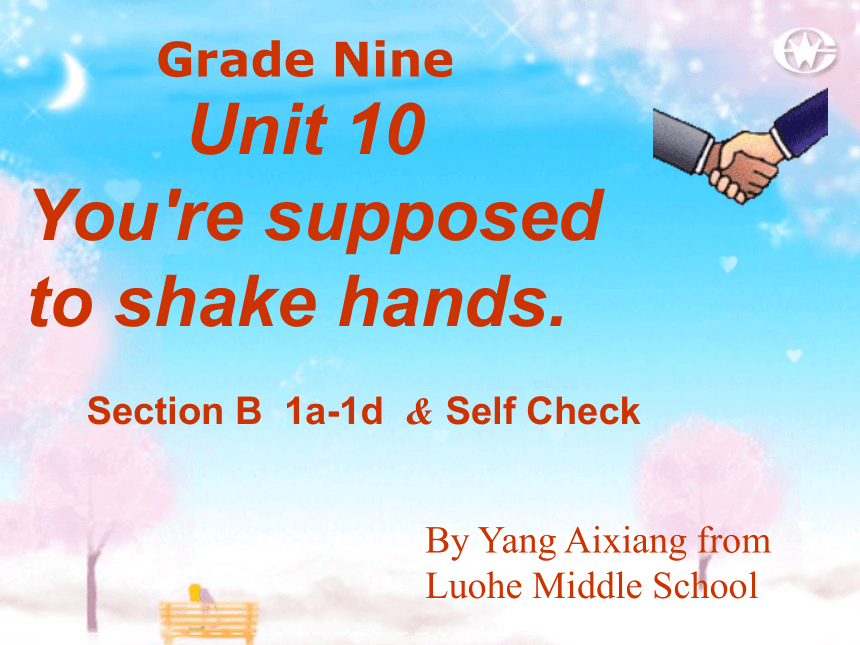 | |
| 格式 | zip | ||
| 文件大小 | 695.0KB | ||
| 资源类型 | 教案 | ||
| 版本资源 | 人教新目标(Go for it)版 | ||
| 科目 | 英语 | ||
| 更新时间 | 2015-11-23 09:39:09 | ||
图片预览

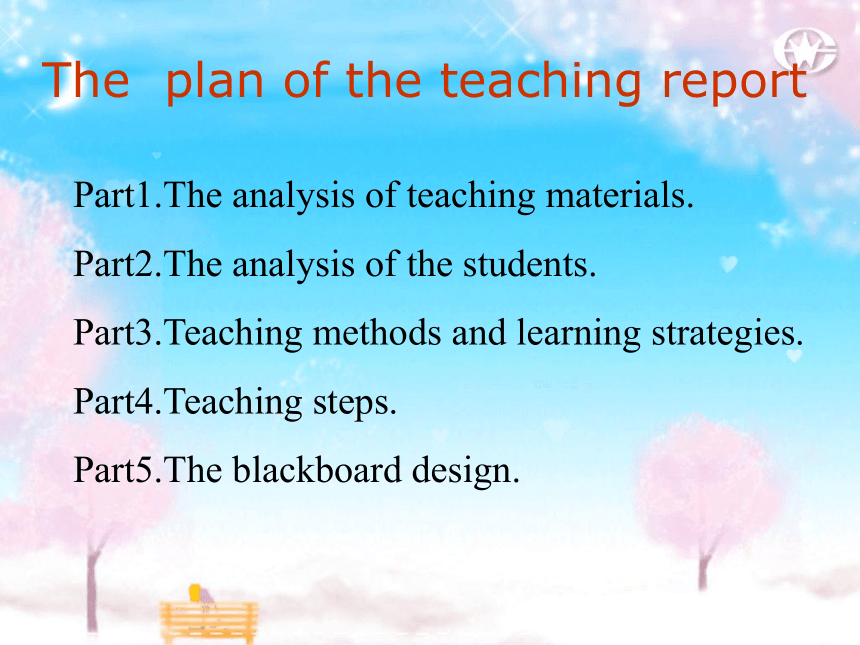
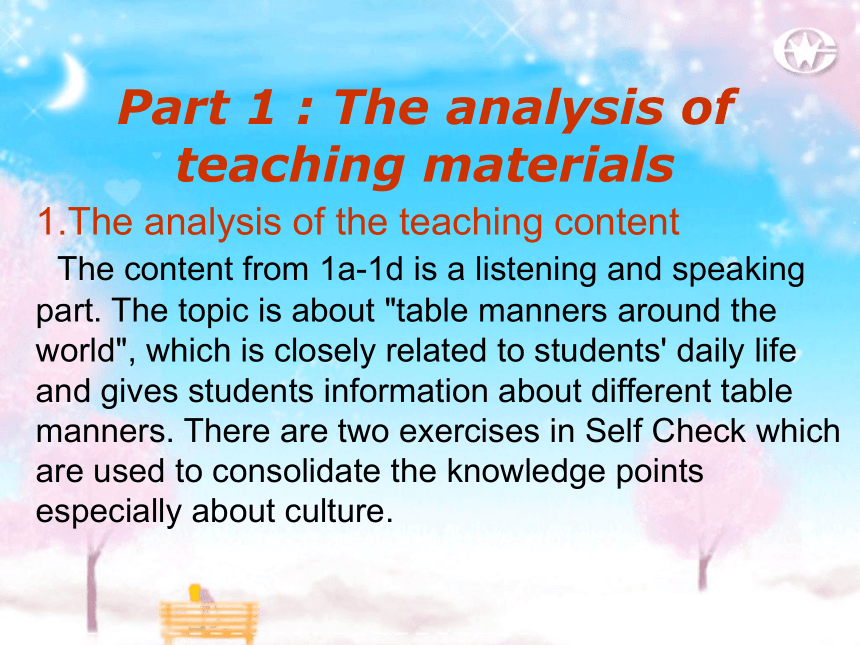
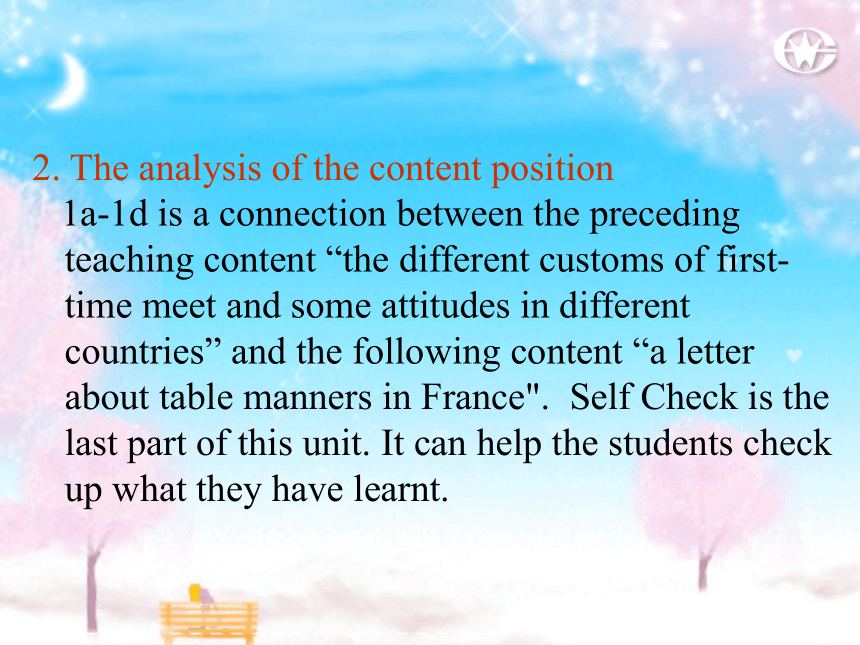
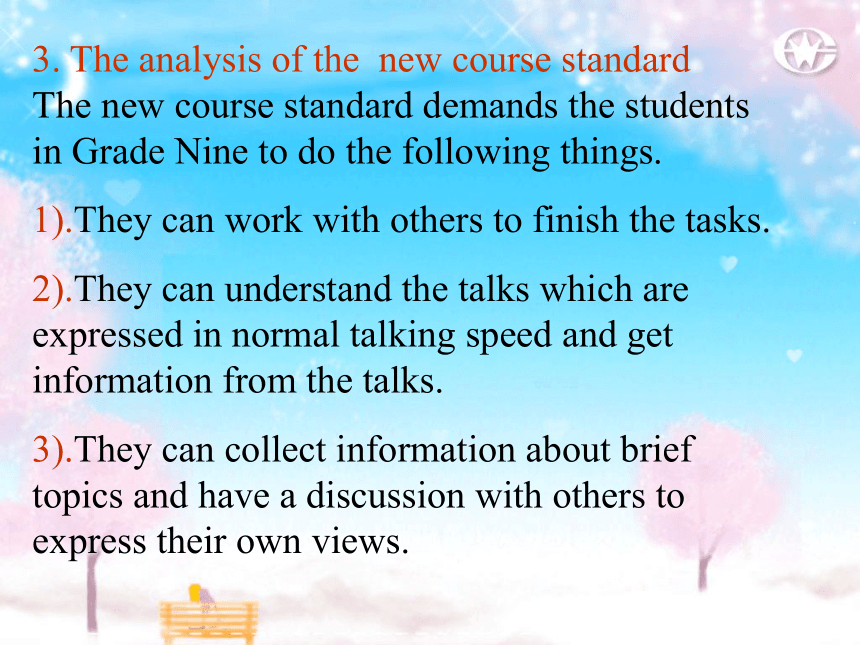
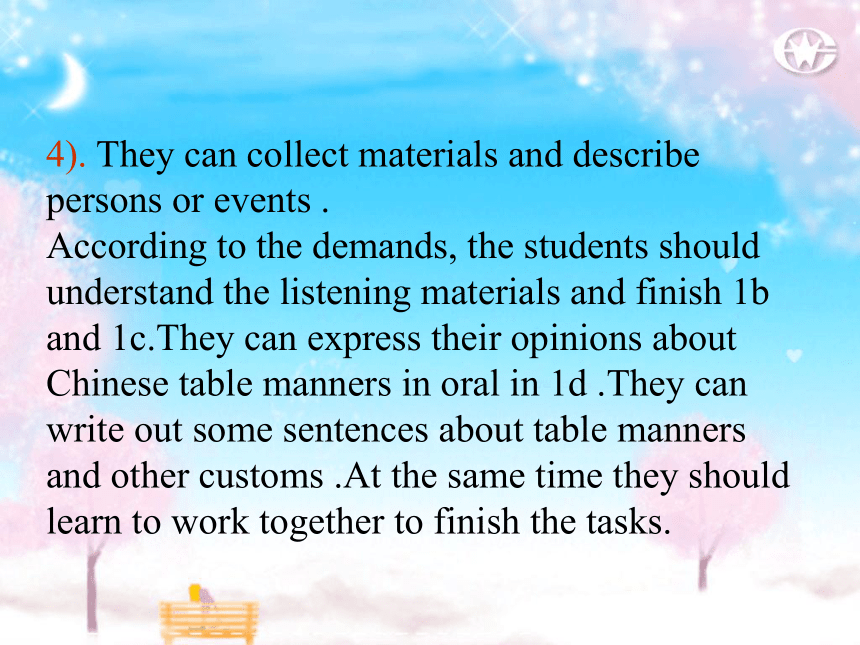
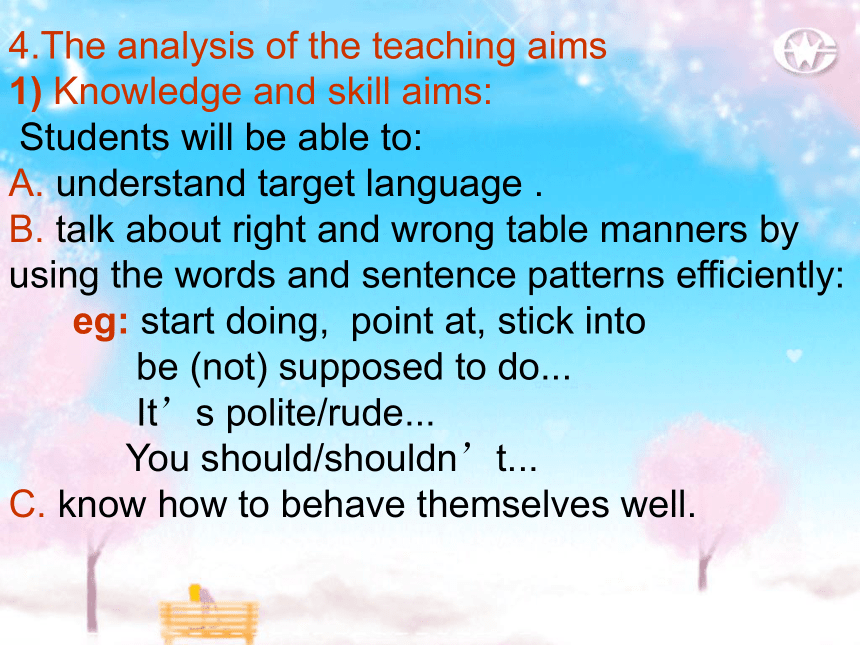
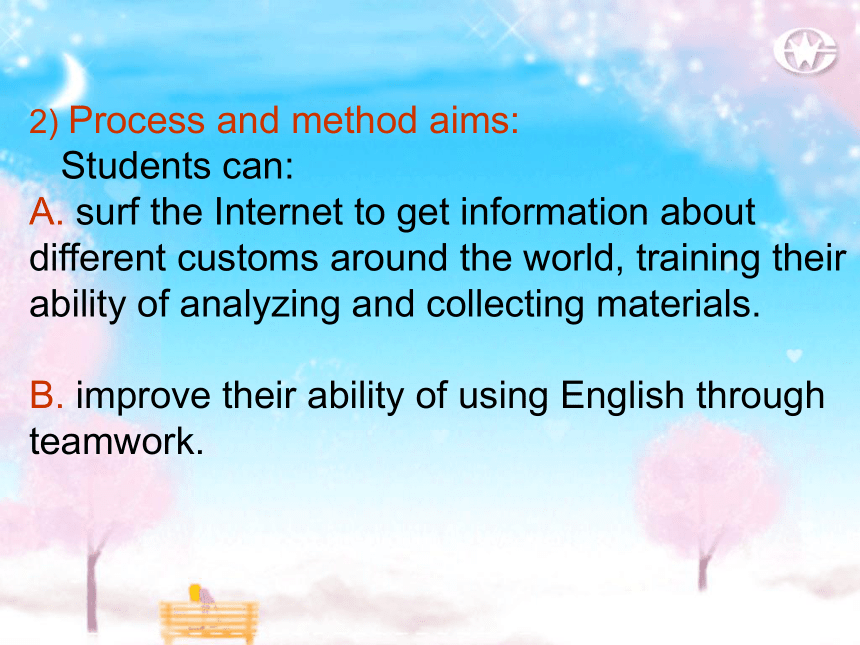

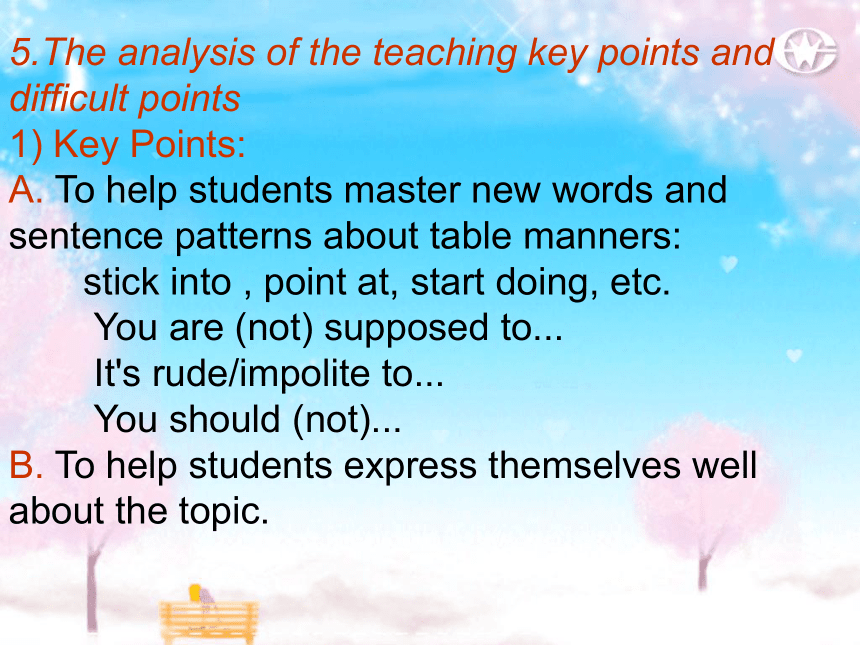
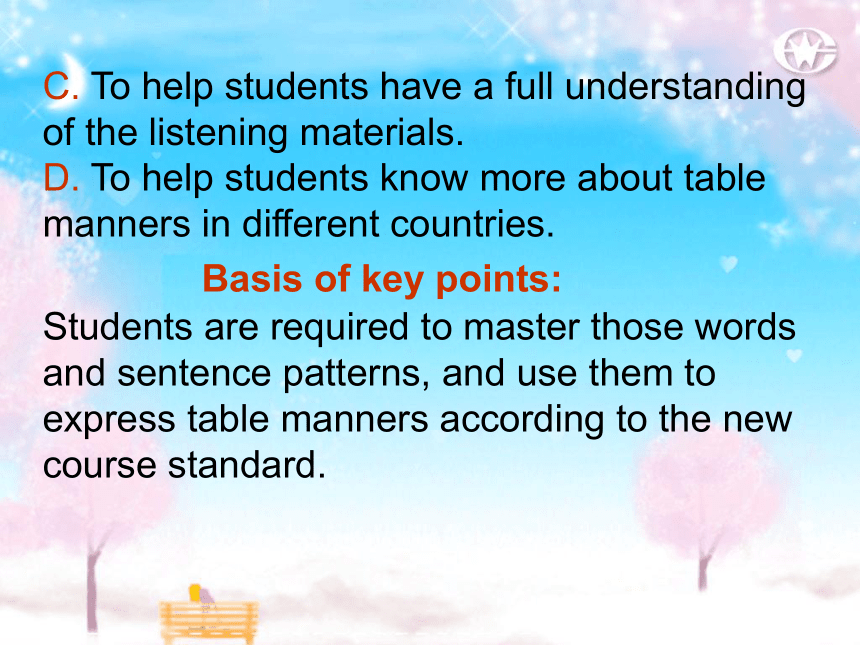
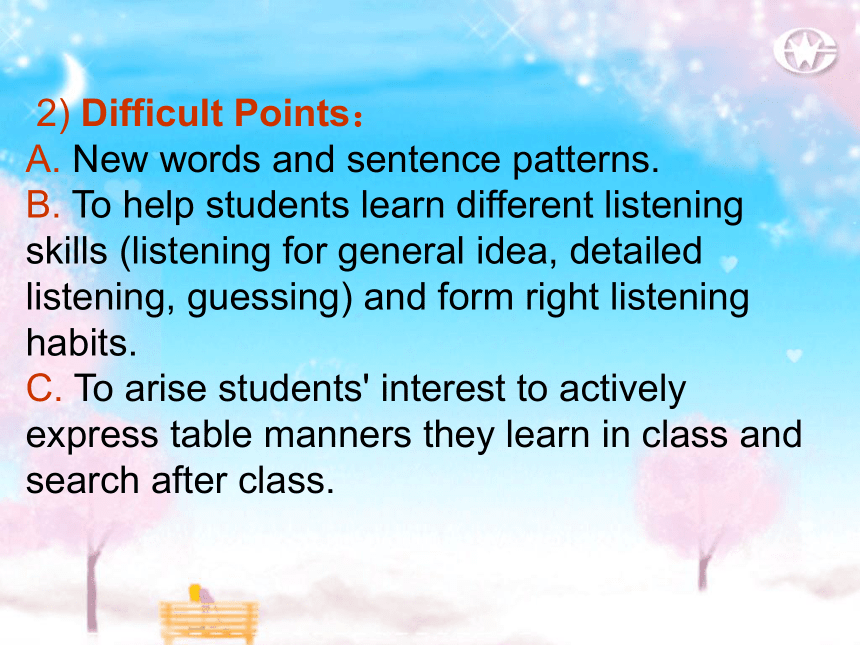
文档简介
课件47张PPT。 Grade Nine
Unit 10
You're supposed to shake hands.Section B 1a-1d & Self CheckBy Yang Aixiang from Luohe Middle School The plan of the teaching reportPart1.The analysis of teaching materials.
Part2.The analysis of the students.
Part3.Teaching methods and learning strategies.
Part4.Teaching steps.
Part5.The blackboard design.Part 1 : The analysis of teaching materials1.The analysis of the teaching content
The content from 1a-1d is a listening and speaking part. The topic is about "table manners around the world", which is closely related to students' daily life and gives students information about different table manners. There are two exercises in Self Check which are used to consolidate the knowledge points especially about culture.
2. The analysis of the content position
1a-1d is a connection between the preceding teaching content “the different customs of first-time meet and some attitudes in different countries” and the following content “a letter about table manners in France". Self Check is the last part of this unit. It can help the students check up what they have learnt.
3. The analysis of the new course standard
The new course standard demands the students in Grade Nine to do the following things.
1).They can work with others to finish the tasks.
2).They can understand the talks which are expressed in normal talking speed and get information from the talks.
3).They can collect information about brief topics and have a discussion with others to express their own views.4). They can collect materials and describe persons or events .
According to the demands, the students should understand the listening materials and finish 1b and 1c.They can express their opinions about Chinese table manners in oral in 1d .They can write out some sentences about table manners and other customs .At the same time they should learn to work together to finish the tasks.4.The analysis of the teaching aims
1) Knowledge and skill aims:
Students will be able to:
A. understand target language .
B. talk about right and wrong table manners by using the words and sentence patterns efficiently:
eg: start doing, point at, stick into
be (not) supposed to do...
It’s polite/rude...
You should/shouldn’t...
C. know how to behave themselves well. 2) Process and method aims:
Students can:
A. surf the Internet to get information about different customs around the world, training their ability of analyzing and collecting materials.
B. improve their ability of using English through teamwork.3) Emotional attitudes and views of value:Students will know more about foreign culture, learn to pay attention to and respect other countries' culture and also deepen the understanding of Chinese culture.
5.The analysis of the teaching key points and difficult points
1) Key Points:
A. To help students master new words and sentence patterns about table manners:
stick into , point at, start doing, etc.
You are (not) supposed to...
It's rude/impolite to...
You should (not)...
B. To help students express themselves well about the topic.
C. To help students have a full understanding of the listening materials.
D. To help students know more about table manners in different countries.
Basis of key points:
Students are required to master those words and sentence patterns, and use them to express table manners according to the new course standard. 2) Difficult Points:
A. New words and sentence patterns.
B. To help students learn different listening skills (listening for general idea, detailed listening, guessing) and form right listening habits.
C. To arise students' interest to actively express table manners they learn in class and search after class. Basis of difficult points:
The students are clever and hard-working; But they don’t have enough chances to listen and use English, and they're not so active to express themselves in class.Part 2:The analysis of the students
Students have already learned:
1) some words and sentence patterns about expressing customs.
2) some information about different customs of first-time meet and other attitudes in different countries.
They can use them efficiently to express customs both in China and in other countries. But they lack the experience of foreign restaurants and real language environment.Part 3: Teaching methods
& learning strategies 1.Teaching methods:
1) task-based teaching method
2) multimedia method
3) communicative method
Basis of teaching methods
the demand of new course standard ,the analysis of teaching materials and the analysis of students.
2.Teaching aids:
Computer, multimedia,blackboard and chalk.
3.Learning Strategies:
1) Cognitive strategies: to grasp the main idea of the listening materials, as well as the detailed information using listening skills.
2) Communicative strategies: to interact with the teacher, and to cooperate with partners to finish the tasks.
Basis of Learning Strategies
student-centered class demanded by new course standard
Part 4:Teaching stepsLead-in 3mins
Presentation 5mins
A quit 3mins
Listening 8mins
Discussion 10mins
Writing 10mins
Exercises 3mins
Summary 2mins
Homework 1minStep 1: Lead-in (3mins) 1.Ask the student to do the daily report which is about this unit.
2. Review the words and expressions learned in last class Purpose of this part:
Give a general revision of what students have learned last time to make preparation for the coming teaching content and help students get themselves into learning state.Show them some pictures of table manners, and explain them to make sure they know clearly.Step 2.Presentation (5mins)Purpose of this part:
Get the students to know different countries have different table manners, and what the table manners are.
How much do you know about table manners?PresentationIn India, you are supposed to eat with your hands. In China, you’re not supposed to stick your chopsticks into the food.In Korea, the youngest person isn’t expected to start eating first.In France, you’re supposed to put your bread on the table. In China, it’s impolite to use your chopsticks to hit an empty (空的)bowl.Step 3.A quit(3mins)Get them to circle T for true or F for false after each sentence, them check up the answers one by one.Purpose of this part:
Check up if the students can remember the table manners in different countries.1aHow much do you know about table manners around the world? Take the following quiz. Circle T for true or F for false after each sentence.A quizMind your manners!
1. In India, you’re supposed to eat with your hands. T F
2. In China, you’re not supposed to stick your chopsticks into the food. T F
3. In Korea, the youngest person is expected to start eating first. T F4. In France, you’re supposed to put your bread on the table. T F
5. In China, it’s impolite to use your chopsticks to hit an empty bowl. T FStep 4.Listening (8mins)1.Before playing the tape ,tell them what they should do and how to do it .
2.Ask students to listen to the conversation for the main idea and number the pictures in1b.
3.Then check the answers to1b with class
4.Get them to listen again and match the sentence parts.
5.Check up the answers to 1c together.
Purpose of this part:
Apply two different kinds of listening skills: listening for main idea and listening for details to train students' listening ability of getting information from listening materials quickly. Explanations help students' grasp of those key words and expressions.
6.Explain the sentence patterns. eg: You’re not supposed to ,It’s impolite to
1231bSteve is going to China to study. His friend Yang Ming is telling him about the table manners in China. Listen and number the pictures in the order you hear them.ListeningListen again. Match the sentence parts.acb1cStep 5 .Discussion(10mins)Show them some pictures of other table manners in China, and let them work in pairs like the model.Purpose of this part:
1.Create chances for the students to practice their spoken English and know more about table manners.
2.Improve the ability of teamwork.
3.Consolidate the sentence patterns just learned.
4.Students have a better understanding of table manners in China.
A: We’re supposed to…
B: Yes, and it’s impolite to…Talk about other table manners in your country.1dDiscussionStep 6.Writing (10mins)1.Ask them to write some sentences about the table manners and other manners in China by using the sentence patterns.
2.The teacher makes a conclusion to the writing.Purpose of this part:
1.Create chances for the students to practice their written English.
2.Improve the ability of teamwork.
3.Consolidate the sentence patterns just learned.
4.Share more information about manners.Write down your opinions about Chinese table manners in groups.1.It’s not necessary to order too many dishes.
2.It’s polite to let the old people sit down first before eating dinner.
Writing3.You’re not supposed to talk loudly when you’re having dinner.
4. You shouldn’t clean your teeth with a toothpick at table.
5. It’s impolite to use your chopsticks to hit an empty bowl.
6.You’re not supposed to smoke at table.Talk about other manners in our culture 1.When you are visiting sb for the first time2.When you are waiting for a line at a bus stop.eg: You’re supposed to bring a small gift.
It’s polite to call first
eg: It’s polite to wait in line.
You’re expected to let the old get on the bus first.Step 7.Exercises (3mins)Part1of Self Check is about some customs ,get them to do by themselves, them check up.Purpose of this part:
Improve the ability of understanding the sentences, and get them to know more about customs.
1. In many countries, it is impolite to show up at someone’s house for the first time with __________hands. You should always bring a small gift.
2. Billy was very uncomfortable at a fine-dining restaurant last night because he didn’t know ___________table manners.
3. It is _________spending the time to learn about the customs of a country before you go there. That way, you will know what you are supposed to do in different situations.
Fill in the blanks with the words in the box. empty basic worthworth, capital, basic, traffic, empty, mad, knocking4. The ______________ is always the worst in the ________city. It is important to leave earlier if you are traveling by car.
5. Sandy went into her sister’s room without ___________ on the door. That made her sister____________.traffic capital knockingmad Step 8.Summary (2mins)Ask sb to tell us what we have learnt in this period. Then the teacher adds sth.Purpose of this part:
Improve the ability of summarizing, and make sure they know what they have learnt in this period.Step 9.Homework(1min)Write an email about Chinese table manners, and surf the Internet to look up more customs in foreign countries.Purpose of this part:
1.Improve the ability of writing.
2.Consolidate the knowledge points just learned.
3.Share more information about customs.Part 5:Blackboard designYou're (not) supposed to...
It's impolite/polite to...
You shoud/shoudn't...empty stick into
point at start doingPurpose of this part:
Make the knowledge points clear.Thanks for listening!
Unit 10
You're supposed to shake hands.Section B 1a-1d & Self CheckBy Yang Aixiang from Luohe Middle School The plan of the teaching reportPart1.The analysis of teaching materials.
Part2.The analysis of the students.
Part3.Teaching methods and learning strategies.
Part4.Teaching steps.
Part5.The blackboard design.Part 1 : The analysis of teaching materials1.The analysis of the teaching content
The content from 1a-1d is a listening and speaking part. The topic is about "table manners around the world", which is closely related to students' daily life and gives students information about different table manners. There are two exercises in Self Check which are used to consolidate the knowledge points especially about culture.
2. The analysis of the content position
1a-1d is a connection between the preceding teaching content “the different customs of first-time meet and some attitudes in different countries” and the following content “a letter about table manners in France". Self Check is the last part of this unit. It can help the students check up what they have learnt.
3. The analysis of the new course standard
The new course standard demands the students in Grade Nine to do the following things.
1).They can work with others to finish the tasks.
2).They can understand the talks which are expressed in normal talking speed and get information from the talks.
3).They can collect information about brief topics and have a discussion with others to express their own views.4). They can collect materials and describe persons or events .
According to the demands, the students should understand the listening materials and finish 1b and 1c.They can express their opinions about Chinese table manners in oral in 1d .They can write out some sentences about table manners and other customs .At the same time they should learn to work together to finish the tasks.4.The analysis of the teaching aims
1) Knowledge and skill aims:
Students will be able to:
A. understand target language .
B. talk about right and wrong table manners by using the words and sentence patterns efficiently:
eg: start doing, point at, stick into
be (not) supposed to do...
It’s polite/rude...
You should/shouldn’t...
C. know how to behave themselves well. 2) Process and method aims:
Students can:
A. surf the Internet to get information about different customs around the world, training their ability of analyzing and collecting materials.
B. improve their ability of using English through teamwork.3) Emotional attitudes and views of value:Students will know more about foreign culture, learn to pay attention to and respect other countries' culture and also deepen the understanding of Chinese culture.
5.The analysis of the teaching key points and difficult points
1) Key Points:
A. To help students master new words and sentence patterns about table manners:
stick into , point at, start doing, etc.
You are (not) supposed to...
It's rude/impolite to...
You should (not)...
B. To help students express themselves well about the topic.
C. To help students have a full understanding of the listening materials.
D. To help students know more about table manners in different countries.
Basis of key points:
Students are required to master those words and sentence patterns, and use them to express table manners according to the new course standard. 2) Difficult Points:
A. New words and sentence patterns.
B. To help students learn different listening skills (listening for general idea, detailed listening, guessing) and form right listening habits.
C. To arise students' interest to actively express table manners they learn in class and search after class. Basis of difficult points:
The students are clever and hard-working; But they don’t have enough chances to listen and use English, and they're not so active to express themselves in class.Part 2:The analysis of the students
Students have already learned:
1) some words and sentence patterns about expressing customs.
2) some information about different customs of first-time meet and other attitudes in different countries.
They can use them efficiently to express customs both in China and in other countries. But they lack the experience of foreign restaurants and real language environment.Part 3: Teaching methods
& learning strategies 1.Teaching methods:
1) task-based teaching method
2) multimedia method
3) communicative method
Basis of teaching methods
the demand of new course standard ,the analysis of teaching materials and the analysis of students.
2.Teaching aids:
Computer, multimedia,blackboard and chalk.
3.Learning Strategies:
1) Cognitive strategies: to grasp the main idea of the listening materials, as well as the detailed information using listening skills.
2) Communicative strategies: to interact with the teacher, and to cooperate with partners to finish the tasks.
Basis of Learning Strategies
student-centered class demanded by new course standard
Part 4:Teaching stepsLead-in 3mins
Presentation 5mins
A quit 3mins
Listening 8mins
Discussion 10mins
Writing 10mins
Exercises 3mins
Summary 2mins
Homework 1minStep 1: Lead-in (3mins) 1.Ask the student to do the daily report which is about this unit.
2. Review the words and expressions learned in last class Purpose of this part:
Give a general revision of what students have learned last time to make preparation for the coming teaching content and help students get themselves into learning state.Show them some pictures of table manners, and explain them to make sure they know clearly.Step 2.Presentation (5mins)Purpose of this part:
Get the students to know different countries have different table manners, and what the table manners are.
How much do you know about table manners?PresentationIn India, you are supposed to eat with your hands. In China, you’re not supposed to stick your chopsticks into the food.In Korea, the youngest person isn’t expected to start eating first.In France, you’re supposed to put your bread on the table. In China, it’s impolite to use your chopsticks to hit an empty (空的)bowl.Step 3.A quit(3mins)Get them to circle T for true or F for false after each sentence, them check up the answers one by one.Purpose of this part:
Check up if the students can remember the table manners in different countries.1aHow much do you know about table manners around the world? Take the following quiz. Circle T for true or F for false after each sentence.A quizMind your manners!
1. In India, you’re supposed to eat with your hands. T F
2. In China, you’re not supposed to stick your chopsticks into the food. T F
3. In Korea, the youngest person is expected to start eating first. T F4. In France, you’re supposed to put your bread on the table. T F
5. In China, it’s impolite to use your chopsticks to hit an empty bowl. T FStep 4.Listening (8mins)1.Before playing the tape ,tell them what they should do and how to do it .
2.Ask students to listen to the conversation for the main idea and number the pictures in1b.
3.Then check the answers to1b with class
4.Get them to listen again and match the sentence parts.
5.Check up the answers to 1c together.
Purpose of this part:
Apply two different kinds of listening skills: listening for main idea and listening for details to train students' listening ability of getting information from listening materials quickly. Explanations help students' grasp of those key words and expressions.
6.Explain the sentence patterns. eg: You’re not supposed to ,It’s impolite to
1231bSteve is going to China to study. His friend Yang Ming is telling him about the table manners in China. Listen and number the pictures in the order you hear them.ListeningListen again. Match the sentence parts.acb1cStep 5 .Discussion(10mins)Show them some pictures of other table manners in China, and let them work in pairs like the model.Purpose of this part:
1.Create chances for the students to practice their spoken English and know more about table manners.
2.Improve the ability of teamwork.
3.Consolidate the sentence patterns just learned.
4.Students have a better understanding of table manners in China.
A: We’re supposed to…
B: Yes, and it’s impolite to…Talk about other table manners in your country.1dDiscussionStep 6.Writing (10mins)1.Ask them to write some sentences about the table manners and other manners in China by using the sentence patterns.
2.The teacher makes a conclusion to the writing.Purpose of this part:
1.Create chances for the students to practice their written English.
2.Improve the ability of teamwork.
3.Consolidate the sentence patterns just learned.
4.Share more information about manners.Write down your opinions about Chinese table manners in groups.1.It’s not necessary to order too many dishes.
2.It’s polite to let the old people sit down first before eating dinner.
Writing3.You’re not supposed to talk loudly when you’re having dinner.
4. You shouldn’t clean your teeth with a toothpick at table.
5. It’s impolite to use your chopsticks to hit an empty bowl.
6.You’re not supposed to smoke at table.Talk about other manners in our culture 1.When you are visiting sb for the first time2.When you are waiting for a line at a bus stop.eg: You’re supposed to bring a small gift.
It’s polite to call first
eg: It’s polite to wait in line.
You’re expected to let the old get on the bus first.Step 7.Exercises (3mins)Part1of Self Check is about some customs ,get them to do by themselves, them check up.Purpose of this part:
Improve the ability of understanding the sentences, and get them to know more about customs.
1. In many countries, it is impolite to show up at someone’s house for the first time with __________hands. You should always bring a small gift.
2. Billy was very uncomfortable at a fine-dining restaurant last night because he didn’t know ___________table manners.
3. It is _________spending the time to learn about the customs of a country before you go there. That way, you will know what you are supposed to do in different situations.
Fill in the blanks with the words in the box. empty basic worthworth, capital, basic, traffic, empty, mad, knocking4. The ______________ is always the worst in the ________city. It is important to leave earlier if you are traveling by car.
5. Sandy went into her sister’s room without ___________ on the door. That made her sister____________.traffic capital knockingmad Step 8.Summary (2mins)Ask sb to tell us what we have learnt in this period. Then the teacher adds sth.Purpose of this part:
Improve the ability of summarizing, and make sure they know what they have learnt in this period.Step 9.Homework(1min)Write an email about Chinese table manners, and surf the Internet to look up more customs in foreign countries.Purpose of this part:
1.Improve the ability of writing.
2.Consolidate the knowledge points just learned.
3.Share more information about customs.Part 5:Blackboard designYou're (not) supposed to...
It's impolite/polite to...
You shoud/shoudn't...empty stick into
point at start doingPurpose of this part:
Make the knowledge points clear.Thanks for listening!
同课章节目录
- Unit 1 How can we become good learners.
- Section A
- Section B
- Unit 2 I think that mooncakes are delicious!
- Section A
- Section B
- Unit 3 Could you please tell me where the restroom
- Section A
- Section B
- Unit 4 I used to be afraid of the dark.
- Section A
- Section B
- Unit 5 What are the shirts made of?
- Section A
- Section B
- Review of Units 1-5
- Unit 6 When was it invented?
- Section A
- Section B
- Unit 7 Teenagers should be allowed to choose their
- Section A
- Section B
- Unit 8 It must belong to Carla.
- Section A
- Section B
- Unit 9 I like music that I can dance to.
- Section A
- Section B
- Unit 10 You're supposed to shake hands.
- Section A
- Section B
- Review of Units 6-10
- Unit 11 Sad movies make me cry.
- Section A
- Section B
- Unit 12 Life is full of the unexpected
- Section A
- Section B
- Unit 13 We're trying to save the earth!
- Section A
- Section B
- Unit 14 I remember meeting all of you in Grade 7.
- Section A
- Section B
- Review of Units 11-14
